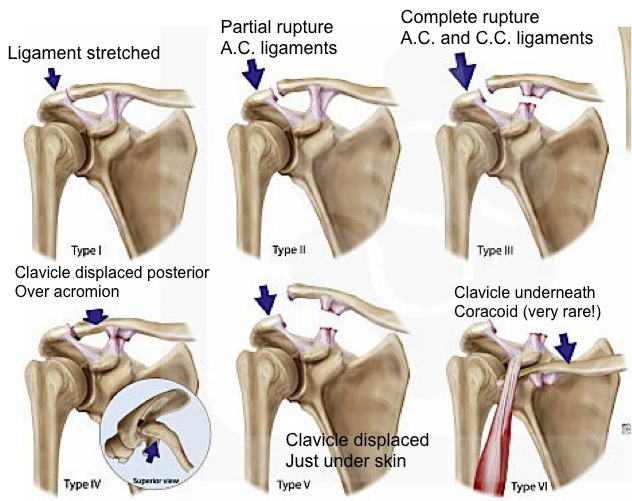
Find us on Facebook and leave your like.
Last article we talked about the most common injuries in running.
Now let’s talk about Brazilian Jiu Jitsu, Judo and different forms of grappling. These martial arts don’t have repetitive movements like running and cycling, but injuries will be there due to powerful forces applied to the joints.
Our focus today will be the shoulder joint.


Be aware: Proper techniques of break falls can help you to reduce the risk of injury.
The most common shoulder injuries are:

1- An acromioclavicular (AC) joint injury is commonly referred to as “shoulder separation” and should not be confused with a shoulder dislocation. Your acromioclavicular joint (or AC Joint) is the joint at the top of your shoulder between your clavicle (collarbone) and your scapula (shoulder blade)applied to the joints. This injury can be divided into Grade I, II and III.
Most common mechanisms of injury: falls.
Treatment: For the first 48-72 hours think of:
- Paying the PRICE – Protect, Rest, Ice, Compression, Elevation ; and
- Do no HARM – no Heat, Alcohol, Running or Massage.
- Find a good physiotherapist.

2- A sprain (What is a sprain? we talked about it here) that tears ligaments in the shoulder most often occurs at the joint between the acromion and collarbone, the acromioclavicular joint . However, we have got different ligaments in the shoulder that also can be affected. We can see these ligaments above. These ligaments can be damaged and every ligament can give you a different pain pattern. Normally, a physiotherapist will help you to understand what tissues have been damaged.
AC joint injuries level I, sometimes level II and ligament sprains in general can be treated with conservative management.
Most common mechanisms of injury: falls and armlocks (americana, kimuras, armbar).
Treatment: For the first 48-72 hours think of:
- Paying the PRICE – Protect, Rest, Ice, Compression, Elevation ; and
- Do no HARM – no Heat, Alcohol, Running or Massage.
- Find a good physiotherapist.

3- A dislocated shoulder usually happens after a heavy fall onto the arm. It takes between 12 and 16 weeks to heal after the shoulder has been put back into place.
Dislocating your shoulder means the ball joint of your upper arm has popped out of the shoulder socket. The surrounding tissues may also have become overstretched or torn.
The shoulder is one of the easiest joints to dislocate because the ball joint sits in a very shallow socket. This makes the arm extremely mobile and able to move in many directions, but also means it’s not very stable.
Most people dislocate their shoulder during a contact sport such as rugby, MMA, sambo, judo, jiu jitsu or in a sports-related accident. In older people the cause is often falling onto outstretched hands, for example after slipping on ice.
Shoulder dislocations can occur more easily in people who are highy flexible, such as those with joint hypermobility (loose joints).
Most common mechanisms of injury: falls
Treatment:
If you think you have dislocated your shoulder, go to your nearest accident and emergency (A&E) department immediately.
Don’t try to pop your arm back in yourself, as this could damage the tissues, nerves and blood vessels around the shoulder joint.
While waiting for medical help, avoid moving your upper arm as much as possible. Place something soft, such as a folded blanket or pillow, in the gap between the arm and side of the chest to support it. If you can, make a simple sling to hold the lower arm across the chest, with the elbow bent at a right angle.
How a dislocated shoulder is treated???
When you get to A&E, you will be assessed and examined. You will usually be X-rayed to make sure you haven’t broken any bones, as it’s fairly common for someone who has dislocated their shoulder to also break the bone of their upper arm or the joint.
If you do have a fracture, further scans may also be carried out to investigate it in more detail. Fractures with a shoulder dislocation will require specialist orthopaedic care and may involve surgery.
If you don’t have any fractures, your arm will be gently manipulated back into its shoulder joint using a procedure known as reduction.
Surgery is sometimes necessary if the tissues surrounding the joint are badly torn and the joint is not stable. If the tissues are overstretched but not torn, surgery can sometimes be avoided by doing appropriate exercises to strengthen the shoulder.
Observation: We are giving you some tips here, but nothing is better that a good physiotherapist and physiotherapy. It can help you to accelerate your recovery from injuries






